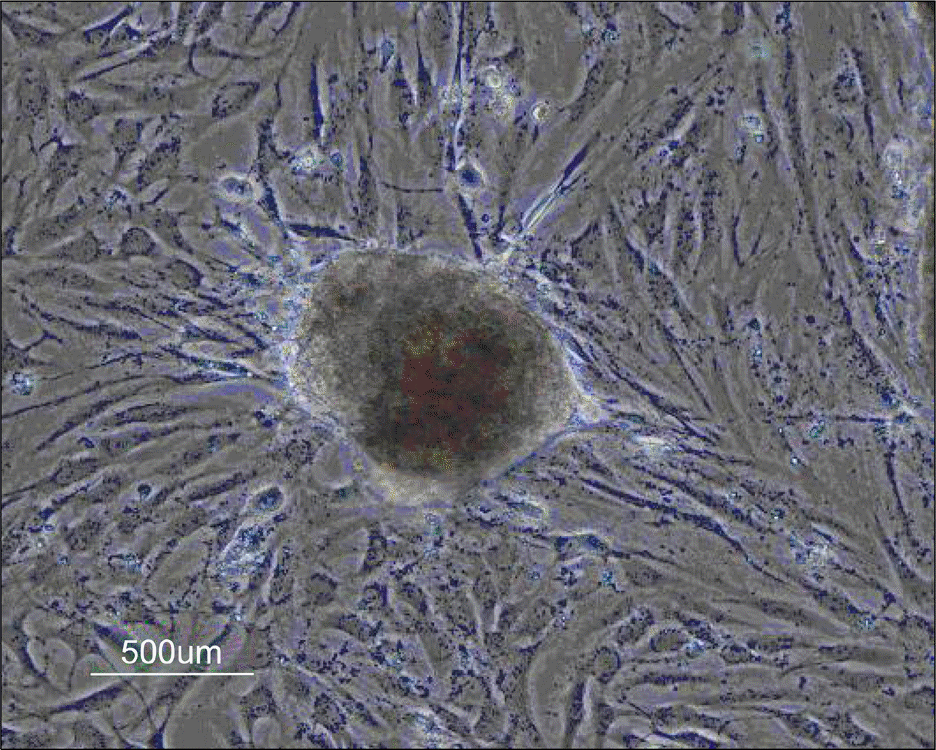Abstract
Purpose
We determined the usefulness of in vitro germ cell culture in nonobstructive azoospermic patients diagnosed with Sertoli cell only syndrome, no sperm in testicular sperm extraction.
Materials and Methods
This study included 44 patients (45 testicular tissues) with nonobstructive azoospermia who were diagnosed with Sertoli cell only syndrome and were found to have no sperm in testicular sperm extraction between January 2006 and July 2008. Among the 45 testicular tissues, 22 tissues were processed for culture. In the in vitro cultures, the testicular tissues were dissociated and plated on gelatin-coated dishes. Patients were divided into 2 groups according to culture success: group I, culture positive (+; n=10); and group II, culture negative (−; n=12).
Results
The mean patient ages were 31.73 and 31.68 years for groups I and II, respectively. The mean testicular sizes were 10.19 and 10.42 cc, respectively; the semen volumes were 2.86 and 3.04 cc, respectively; and the mean FSH, LH, and testosterone levels were 18.86 mIU/ml, 5.99 mIU/ml, and 4.46 ng/ml vs. 21.02 mIU/ml, 6.29 mIU/ml, and 4.32 ng/ml for groups I and II, respectively, with no significant differences between the groups (p>0.05). The culture rate of nonobstructive azoospermic patients diagnosed with Sertoli cell only syndrome was 45.5% (10/22). Round spermatid injection was done in 2 patients with consent of the patients, but implantation failed. Among the 45 tissues, germ cells were found in 8 tissues after pathologic reexamination.
Go to : 
REFERENCES
1.del Castillo EB., Trabucco A., de la Balze FA. Syndrome produced by absence of the germinal epithelium without impairment of the Sertoli or Leydig cells. J Clin Endocrinol Metab. 1947. 7:993.
2.Kim CS., Lee HY. Sertoli cell only syndrome. Korean J Urol. 1987. 28:97–104.
3.Korean Andrology Society. Textbook of andrology. 1st ed.Seoul: Koonja Publishing Inc;2003. 137-65.
4.Ezeh UI., Moore HD., Cooke ID. Correlation of testicular sperm extraction with morphological, biophysical and endocrine profiles in men with azoospermia due to primary gonadal failure. Hum Reprod. 1998. 13:3066–74.

5.Lee DR., Kim KS., Yang YH., Oh HS., Lee SH., Chung TG, et al. Isolation of male germ stem cell-like cells from testicular tissue of non-obstructive azoospermic patients and differentiation into haploid male germ cells in vitro. Hum Reprod. 2006. 21:471–6.

6.Ko WJ., Seo JT. Predictive factors of successful testicular sperm recovery in non-obstructive azoospermic patients. Korean J Urol. 2000. 41:381–6.
7.Harris SE., Sandlow JI. Sperm acquisition in nonobstructive azoospermia: what are the options? Urol Clin North Am. 2008. 35:235–42.

8.Ubaldi F., Nagy ZP., Rienzi L., Tesarik J., Anniballo R., Franco G, et al. Reproductive capacity of spermatozoa from men with testicular failure. Hum Reprod. 1999. 14:2796–800.

9.Devroey P., Liu J., Nagy Z., Goossens A., Tournaye H., Camus M, et al. Pregnancies after testicular sperm extraction and intracytoplasmic sperm injection in non-obstructive azoospermia. Hum Reprod. 1995. 10:1457–60.

10.Tournaye H., Camus M., Goossens A., Liu J., Nagy P., Silber S, et al. Recent concepts in the management of infertility because of non-obstructive azoospermia. Hum Reprod. 1995. 10(Suppl 1):115–9.

11.Park WH., Rou CH., Choo KW. The relationship between the size of the testis and plasma hormonal levels in Sertoli cell only syndrome. Korean J Urol. 1981. 22:424–8.
12.Wong TW., Straus FH., Jones TM., Warner NE. Pathological aspects of the infertile testis. Urol Clin North Am. 1978. 5:503–30.

13.Seo JT., Ko WJ. Predictive factors of successful testicular sperm recovery in non-obstructive azoospermia patients. Int J Androl. 2001. 24:306–10.

14.Silber SJ., Van Steirteghem AC., Liu J., Nagy Z., Tournaye H., Devroey P. High fertilization and pregnancy rate after intracytoplasmic sperm injection with spermatozoa obtained from testicle biopsy. Hum Reprod. 1995. 10:148–52.

15.Seo JT., Park YS., Kim JH., Lee YS., Jun JH., Lee HJ, et al. The treatment of non-obstructive azoospermia. Korean J Fertil Steril. 1997. 24:95–9.
16.Kahraman S., Ozgur S., Alatas C., Aksoy S., Tasdemir M., Nuhoglu A, et al. Fertility with testicular sperm extraction and intracytoplasmic sperm injection in non-obstructive azoospermic men. Hum Reprod. 1996. 11:756–60.

17.Schlegel PN., Palermo GD., Goldstein M., Menendez S., Zaninovic N., Veeck LL, et al. Testicular sperm extraction with intracytoplasmic sperm injection for nonobstructive azoospermia. Urology. 1997. 49:435–40.

18.Tournaye H., Liu J., Nagy PZ., Camus M., Goossens A., Silber S, et al. Correlation between testicular histology and outcome after intracytoplasmic sperm injection using testicular spermatozoa. Hum Reprod. 1996. 11:127–32.

19.Su LM., Palermo GD., Goldstein M., Veeck LL., Rosenwaks Z., Schlegel PN. Testicular sperm extraction with intracytoplasmic sperm injection for nonobstructive azoospermia: testicular histology can predict success of sperm retrieval. J Urol. 1999. 161:112–6.

20.Hong YK., Shin JS., Lee WS. Investigations on the factors predicting the results of testis sperm extraction. Korean J Urol. 1999. 40:1349–54.
21.Shamblott MJ., Axelman J., Wang S., Bugg EM., Littlefield JW., Donovan PJ, et al. Derivation of pluripotent stem cells from cultured human primordial germ cells. Proc Natl Acad Sci U S A. 1998. 95:13726–31.

22.Tanaka A., Nagayoshi M., Awata S., Mawatari Y., Tanaka I., Kusunoki H. Completion of meiosis in human primary spermatocytes through in vitro coculture with Vero cells. Fertil Steril. 2003. 79(Suppl 1):795–801.

23.Feng LX., Chen Y., Dettin L., Pera RA., Herr JC., Goldberg E, et al. Generation and in vitro differentiation of a spermatogonial cell line. Science. 2002. 297:392–5.

24.Tesarik J., Greco E., Cohen-Bacrie P., Mendoza C. Germ cell apoptosis in men with complete and incomplete spermiogenesis failure. Mol Hum Reprod. 1998. 4:757–62.

25.Tesarik J., Mendoza C., Testart J. Viable embryos from injection of round spermatids into oocytes. N Engl J Med. 1995. 333:525.

Go to : 
Table 1.
Characteristics of patients with Sertoli cell only syndrome (SCO; n=44)
Table 2.
Comparison of parameters in relation to culture success




 PDF
PDF ePub
ePub Citation
Citation Print
Print



 XML Download
XML Download